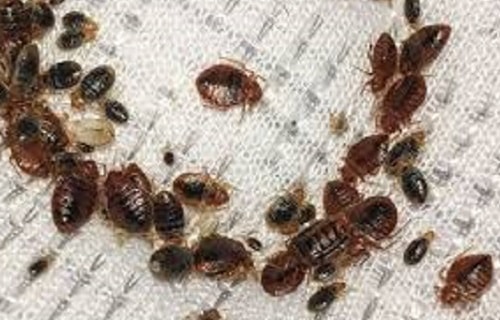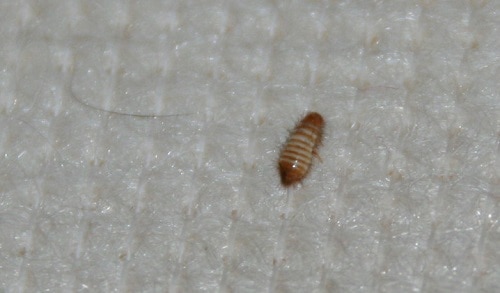- 5 Simple Tricks to Eliminate Maggots From Pet Waste - October 24, 2023
- Keep Your Outdoor Compost Piles Maggot-Free - October 24, 2023
- How to Get Rid of Maggots – Methods that Work - August 30, 2023
For most people, differentiating between bed bugs and carpet beetles is pretty challenging. These two almost look similar, and therefore if you are not keen enough, you might mistake one for the other. There are, however, certain differences that you need to know. This carpet beetles vs bed bugs debate will, therefore, discuss these differences to help you identify and diagnose your bug infestation.
The easiest way of identifying these two bugs is by looking closely to assess them based on their shape and color. In case you cannot achieve this by having a closer look, check out for their behavioral patterns.
Here are some of the key differences:
Physical comparison
Bedbugs are generally small in stature. Their dominant color varies from brown(nymph) to dark brown with red patches. When they feed, they usually turn dark. Bedbugs are insects and therefore have six legs with two antennae that stick out. Carpet beetles look more like ladybugs. They have a wide color variation with no dominant shade. They also have a head and a large rounded shell that is usually uneven. Their shapes, however, resemble ladybugs.
One critical physical difference stems from the head and the thorax of these two. For carpet beetles, therefore, the head and thorax are not clear cut as seen in bedbugs. For the bedbug, the trunk stands typically out from the body.A carpet beetle’s body is also covered by a movable shell which lacks in a bed bug. Bed bugs also have a unique pattern on their back and long rounded abdomens. The lines that run across them horizontally make them expandable to facilitate their feeding.
Bed bugs in carpet


Behavioral differences
These two bugs differ in behavior, which, as we mentioned before, is a crucial differentiating factor. They, therefore, feed on two different things, live in different places and are affected differently by different things.
Let us have a look at these.
Where they live
Bed bugs are found in beds where they feed on their hosts. Carpet beetles, however, live in carpets mostly because it is their crucial feeding point. They, therefore, feed on carpet fibers and dust. Also, have in mind that they are not primarily tied to carpets.They can, therefore, live in Wardrobes where they feed on the cloth fabric, corners of rooms where they feed on dead spiders and a range of insects or in discarded clothes. You can also find a carpet beetle in basements where they usually target dead birds and their nests, or around the bases of upholstered beds or seats.
Carpet bugs can also live in your bed, just that they prefer other places. Bed bugs, on the other hand, live in areas that cannot be easily accessed. They are more of hiding bugs, a reason why they prefer living in mattresses.Bed bugs can also live in areas where there is a small gap between the carpet and the wall if they do not find room underneath the mattress or when there is a pretty large infestation. Another reason why they do not prefer carpets like the carpet beetles is due to their inability to crawl through hair or fur.
Bed bugs, therefore, live underneath the mattress, in cracks around the room and underneath furniture that is located near the bed or on the sofas found in your living room. This makes it challenging to get rid of bed bugs fast. Also, have in mind that these bugs live where they can easily reach you and feed.
Light reception
Bed bugs are generally cautious of light and do not therefore like being in the open. By switching on the lights at night, you will notice that bed bugs stutter away to darkness. Therefore, if you see a bug crawling out in the open during the day, be pretty sure that it is more of a carpet beetle than a bed bug.
Feeding
Another critical discussion that would help differentiate between these two in terms of behavior is their feeding habits. Bed bugs and carpet beetles feed on different things. Bed bugs feed primarily on humans, a reason why they are mostly located on our beds.Carpet beetles, however, do not bite and has a different diet. They, therefore, feed on animal products which include dead skin, fur, hair and feathers. They also feed on wool, dead insects and no-animal fibres.
To identify a bed bug infestation, check for sore spots which are proof of biting. The spots are also itchy and look inflamed. Be keen however not to confuse these biting for mosquito bites. Carpet beetles do not bite, and therefore, such spots do not exist.The fact that carpet beetles do not bite does not mean that they are harmless. You can develop an allergic reaction to these bugs occasioned by their tiny hairs which usually occurs on contact.
These allergic reactions also lead to the formation of spots, which do not, however, resemble the bed bug spots.Bed bugs usually leave small clusters or lines on the body whereas carpet beetle spots generally arise when one crawls on you. It is also important to note that bed bugs feed primarily on blood. The bite marks result on nasty lumps which are usually an allergic reaction to the saliva of the bed bug.
Even though carpet beetles can feed on skin, they do not feed on living skin. Likewise, they also feed on dead insects. They, therefore, have a variety of food sources that can be easily found in the carpet, unlike bed bugs that explicitly rely on blood.
Flying
Unlike carpet beetles, bed bugs cannot fly. They, therefore, rely on their host to move from place to place. They usually live in bedding and therefore lose nothing by their inability to fly. Carpet beetles, on the other hand, heavily rely on flying, which is their primary locomotion means.They rely on their shells which fold outwards as in the case of ladybugs to reveal the wings, a reason why their shells are bisected along the middle. Carpet bugs also need to fly because of their different habitats and variety of prey.
Conclusion
Even though these two bugs look similar and can easily be confused, there are still certain ways of ascertaining, which is which. I hope that this carpet beetles vs bed bugs has shed some light on this.
Source: https://entomology.ca.uky.edu/ef601
https://www.cabdirect.org/cabdirect/abstract/19410500435
Check out other related posts on this site –
Do bed bugs stink?
Do roaches avoid light?
